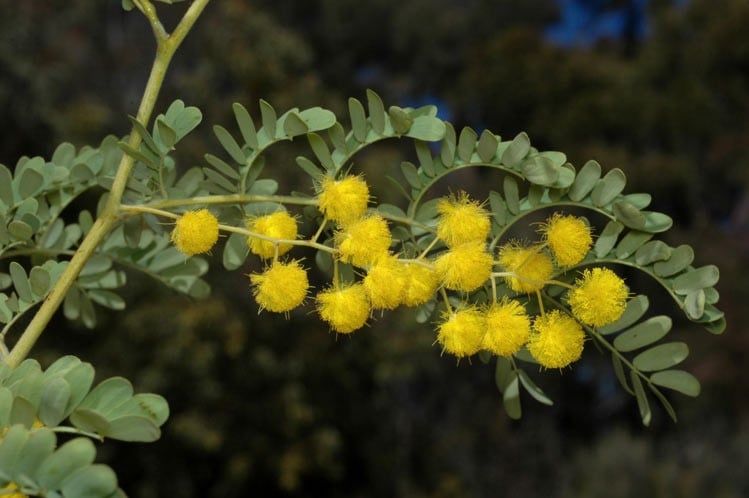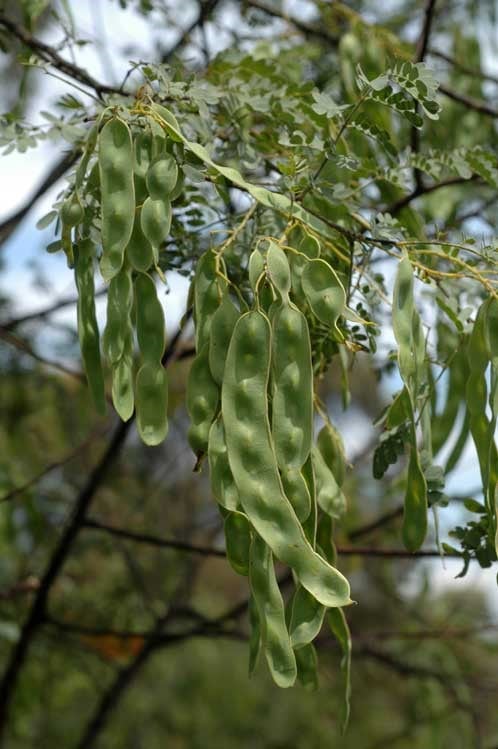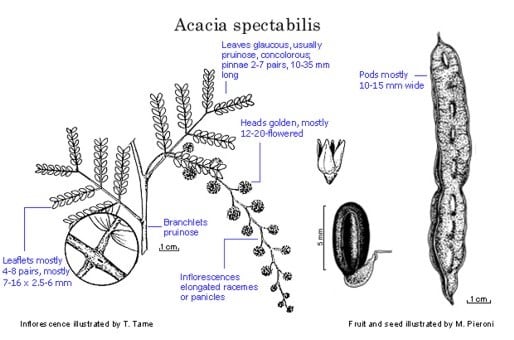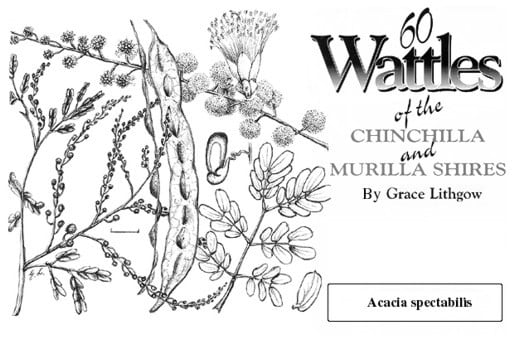Acacia spectabilis A.Cunn. ex Benth.
WATTLE
Acacias of Australia
Common Name
Mudgee Wattle, Pilliga Wattle, Glory Wattle
Family
Fabaceae
Distribution
Extends in south-eastern Qld from Eidsvold and Fraser Is. S to the Darling Downs; common in N.S.W. in the Pilliga Scrub S to Cowra and W to Condobolin, on the slopes and western plains; occasionally naturalised on the North and Central Coast of N.S.W.
Description
Shrub or tree 2–4 (–6) m high. Bark smooth, blue-grey, grey or whitish. Branchlets ±terete, shortly hirsute to glabrous; ridges not prominent. Young foliage-tips velvety cream-coloured to glabrous whitish green or sometimes glaucous purple. Leaves subcoriaceous, blue-green, glaucous; petiole (0.1–) 0.5–1.2 cm long, terete, often with an obscure gland at or near apex, glabrous or hairy; rachis (1–) 2–7 (–8.5) cm long, mostly eglandular, rarely with an orbicular glabrous dark gland at the insertion of apical pinnae, glabrous or hairy; pinnae 2–6 (–7) pairs, (0.5–) 1–3.5 cm long, narrowing towards base; pinnules (2–) 4–8 pairs, narrowly obovate or oblong, (5–) 7–16 mm long, 2.5–6 (–7) mm wide, glabrous, obscurely 2- or 3-nerved, with apex broadly rounded or emarginate, mostly wider than the unequally-sided base. Inflorescences in very elongated axillary racemes, or terminal or axillary false-panicles; peduncles 3–10 mm long. Heads globular, 12–20 (–35)-flowered, golden. Pods ±straight-sided, 4–10 (–17) cm long, (8–) 10–15 (–19) mm wide, thinly coriaceous, purplish or bluish brown, black or dark brown, usually pruinose, glabrous.
Phenology
Flowers mainly July–Nov.; fruits Nov., Dec., June.
Habitat
Grows in open forest, woodland or heath, often associated with Callitris spp., in sandy or gravelly soils, on sandstone, granite or laterite.
Specimens
Qld: 15 miles [24.2 km] W of Dalby, N.T.Burbidge 5462 (CANB, NSW); 22.5 km N of Miles, R.W.Johnson 2786 (BRI, MEL, NSW). N.S.W.: 15.4 km SW of Gooloogong School, R.G.Coveny 12079 & P.Hind (B, MEL, NSW, TL, US); 11.3 km E of Condobolin, G.M.Cunningham & P.L.Milthorpe 2095 (NSW); 69.2 km W of Cowra, M.D.Tindale & J.Lanyon (NSW101332).
Notes
Similar to A. polybotrya which has jugate glands, narrower pods and smaller flower heads.
Often cultivated as an ornamental tree or shrub which is moderately frost resistant.
FOA Reference
Data derived from Flora of Australia Volumes 11A (2001), 11B (2001) and 12 (1998), products of ABRS, ©Commonwealth of Australia
Author
M.D.Tindale, P.G.Kodela
Minor edits by B.R.Maslin & J.Reid
This identification key and fact sheets are available as a mobile application:
URL: https://apps.lucidcentral.org/wattle/
© Copyright 2018. All rights reserved.













